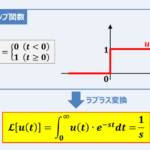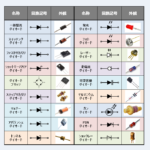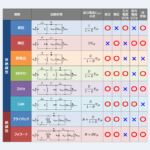この記事では『三角関数(\({\sin}{\omega}t\)と\({\cos}{\omega}t\))』について
- 三角関数(\({\sin}{\omega}t\)と\({\cos}{\omega}t\))のラプラス変換の式と導出方法
などを図を用いて分かりやすく説明するように心掛けています。ご参考になれば幸いです。
三角関数のラプラス変換
\({\sin}{\omega}t\)と\({\cos}{\omega}t\)をラプラス変換すると、次式となります。
\begin{eqnarray}
\displaystyle\mathcal{L}\left[{\sin}{\omega}t\right]=\frac{{\omega}}{s^2+{\omega}^2}\tag{1}\\
\\
\displaystyle\mathcal{L}\left[{\cos}{\omega}t\right]=\frac{s}{s^2+{\omega}^2}\tag{2}
\end{eqnarray}
上式の記号\(\displaystyle\mathcal{L}\)はラプラス変換を表す記号です。\(\displaystyle\mathcal{L}\left[{\sin}{\omega}t\right]\)と書くと、「\({\sin}{\omega}t\)をラプラス変換する」ということになります。なお、\(\displaystyle\mathcal{L}\)はラプラス(Laplace)の頭文字を筆記体で書いたものです。
(1)式と(2)式は覚えた方が便利ですが、忘れても、下記の「ラプラス変換の定義式」の\(f(t)\)に\({\sin}{\omega}t\)や\({\cos}{\omega}t\)を代入すると、(1)式と(2)式を導出することができます。
ラプラス変換の定義式
ラプラス変換\(F(s)\)の定義式は次式となっています。
\begin{eqnarray}
F(s)=\displaystyle\mathcal{L}\left[f(t)\right]={\displaystyle\int}_0^{\infty}f(t){\;}{\cdot}{\;}e^{-st}dt\tag{3}
\end{eqnarray}
(3)式は時間\(t\)の関数\(f(t)\)に\(e^{-st}\)を掛けたものを\(t=0\)から\({\infty}\)まで積分すると、\(s\)の関数\(F(s)\)にラプラス変換できるということを示しています。
ラプラス変換の定義式については下記の記事で詳しく説明しています。興味のある方は下記のリンクからぜひチェックをしてみてください。 続きを見る
ラプラス変換の「定義式」と「公式の導出方法」
では実際に、(3)式のラプラス変換の定義式を用いて、三角関数(\({\sin}{\omega}t\)と\({\cos}{\omega}t\))をラプラス変換してみましょう。
三角関数(\({\sin}{\omega}t\))のラプラス変換
まず、「\({\sin}{\omega}t\)」を「\(e^■\)」の形に変形させます。
オイラーの公式より次式が成り立ちます。
オイラーの公式
\begin{eqnarray}
e^{j{\omega}t}&=&{\cos}{\omega}t+j{\sin}{\omega}t\tag{4}\\
\\
e^{-j{\omega}t}&=&{\cos}{\omega}t-j{\sin}{\omega}t\tag{5}
\end{eqnarray}
(4)式と(5)式を用いると、「\({\sin}{\omega}t\)」は次式のように変形することができます。
\begin{eqnarray}
{\sin}{\omega}t=\frac{1}{2j}(e^{j{\omega}t}-e^{-j{\omega}t})\tag{6}
\end{eqnarray}
ラプラス変換の定義式((3)式)の\(f(t)\)に「\({\sin}{\omega}t\)」を代入すると、次式になります。
\begin{eqnarray}
F(s)=\displaystyle\mathcal{L}\left[{\sin}{\omega}t\right]&=&{\displaystyle\int}_0^{\infty}{\sin}{\omega}t{\;}{\cdot}{\;}e^{-st}dt\\
\\
&=&{\displaystyle\int}_0^{\infty}\frac{1}{2j}(e^{j{\omega}t}-e^{-j{\omega}t}){\;}{\cdot}{\;}e^{-st}dt\\
\\
&=&\frac{1}{2j}\left({\displaystyle\int}_0^{\infty}e^{j{\omega}t}{\;}{\cdot}{\;}e^{-st}dt-{\displaystyle\int}_0^{\infty}e^{-j{\omega}t}{\;}{\cdot}{\;}e^{-st}dt\right)\tag{7}
\end{eqnarray}
ここで、(7)式をよく見てみましょう。(7)式の「\({\displaystyle\int}_0^{\infty}e^{j{\omega}t}{\;}{\cdot}{\;}e^{-st}dt\)」はラプラス変換の定義式((3)式)の\(f(t)\)が\(e^{j{\omega}t}\)になっているものなので、次式で表すことができます。
\begin{eqnarray}
{\displaystyle\int}_0^{\infty}e^{j{\omega}t}{\;}{\cdot}{\;}e^{-st}dt=\displaystyle\mathcal{L}\left[e^{j{\omega}t}\right]\tag{8}
\end{eqnarray}
同様に、(17)式の「\({\displaystyle\int}_0^{\infty}e^{-j{\omega}t}{\;}{\cdot}{\;}e^{-st}dt\)」はラプラス変換の定義式((3)式)の\(f(t)\)が\(e^{-j{\omega}t}\)になっているものなので、次式で表すことができます。
\begin{eqnarray}
{\displaystyle\int}_0^{\infty}e^{-j{\omega}t}{\;}{\cdot}{\;}e^{-st}dt=\displaystyle\mathcal{L}\left[e^{-j{\omega}t}\right]\tag{9}
\end{eqnarray}
(8)式と(9)式を(7)式に代入すると、次式となります。
\begin{eqnarray}
F(s)=\displaystyle\mathcal{L}\left[{\sin}{\omega}t\right]&=&\frac{1}{2j}\left(\displaystyle\mathcal{L}\left[e^{j{\omega}t}\right]-\displaystyle\mathcal{L}\left[e^{-j{\omega}t}\right]\right)\tag{10}
\end{eqnarray}
ここで、「\(\displaystyle\mathcal{L}\left[e^{-at}\right]=\displaystyle\frac{1}{s+a}\)」なので、(8)式の\(\displaystyle\mathcal{L}\left[e^{j{\omega}t}\right]\)と(9)式の\(\displaystyle\mathcal{L}\left[e^{-j{\omega}t}\right]\)は次式で表されます。
\begin{eqnarray}
\displaystyle\mathcal{L}\left[e^{j{\omega}t}\right]&=&\frac{1}{s-j{\omega}}\tag{11}\\
\\
\displaystyle\mathcal{L}\left[e^{-j{\omega}t}\right]&=&\frac{1}{s+j{\omega}}\tag{12}
\end{eqnarray}
(11)式と(12)式を(10)式に代入すると、次式のようになり、「\({\sin}{\omega}t\)」のラプラス変換\(F(s)\)を導出することができます。
\begin{eqnarray}
F(s)=\displaystyle\mathcal{L}\left[{\sin}{\omega}t\right]&=&\frac{1}{2j}\left(\frac{1}{s-j{\omega}}-\frac{1}{s+j{\omega}}\right)\\
\\
&=&\frac{1}{2j}\left(\frac{s+j{\omega}}{s^2+{\omega}^2}-\frac{s-j{\omega}}{s^2+{\omega}^2}\right)\\
\\
&=&\frac{{\omega}}{s^2+{\omega}^2}\tag{13}
\end{eqnarray}
あわせて読みたい
「\(\displaystyle\mathcal{L}\left[e^{-at}\right]=\displaystyle\frac{1}{s+a}\)の導出方法」と「その他の関数のラプラス変換」については下記の記事でまとめています。興味のある方は下記のリンクからぜひチェックをしてみてください。 続きを見る


ラプラス変換の「一覧表・変換表」と「証明」
三角関数(\({\cos}{\omega}t\))のラプラス変換
「\({\cos}{\omega}t\)」のラプラス変換も「\({\sin}{\omega}t\)」のラプラス変換と同様の方法で求めることができます。
まず、「\({\cos}{\omega}t\)」を「\(e^■\)」の形に変形させます。
オイラーの公式より次式が成り立ちます。
オイラーの公式
\begin{eqnarray}
e^{j{\omega}t}&=&{\cos}{\omega}t+j{\sin}{\omega}t\tag{14}\\
\\
e^{-j{\omega}t}&=&{\cos}{\omega}t-j{\sin}{\omega}t\tag{15}
\end{eqnarray}
(14)式と(15)式を用いると、「\({\cos}{\omega}t\)」は次式のように変形することができます。
\begin{eqnarray}
f(t)={\cos}{\omega}t=\frac{1}{2}(e^{j{\omega}t}+e^{-j{\omega}t})\tag{16}
\end{eqnarray}
ラプラス変換の定義式((3)式)の\(f(t)\)に「\({\cos}{\omega}t\)」を代入すると、次式になります。
\begin{eqnarray}
F(s)=\displaystyle\mathcal{L}\left[{\cos}{\omega}t\right]&=&{\displaystyle\int}_0^{\infty}{\cos}{\omega}t{\;}{\cdot}{\;}e^{-st}dt\\
\\
&=&{\displaystyle\int}_0^{\infty}\frac{1}{2}(e^{j{\omega}t}+e^{-j{\omega}t}){\;}{\cdot}{\;}e^{-st}dt\\
\\
&=&\frac{1}{2}\left({\displaystyle\int}_0^{\infty}e^{j{\omega}t}{\;}{\cdot}{\;}e^{-st}dt+{\displaystyle\int}_0^{\infty}e^{-j{\omega}t}{\;}{\cdot}{\;}e^{-st}dt\right)\tag{17}
\end{eqnarray}
ここで、(17)式をよく見てみましょう。(17)式の「\({\displaystyle\int}_0^{\infty}e^{j{\omega}t}{\;}{\cdot}{\;}e^{-st}dt\)」はラプラス変換の定義式((3)式)の\(f(t)\)が\(e^{j{\omega}t}\)になっているものなので、次式で表すことができます。
\begin{eqnarray}
{\displaystyle\int}_0^{\infty}e^{j{\omega}t}{\;}{\cdot}{\;}e^{-st}dt=\displaystyle\mathcal{L}\left[e^{j{\omega}t}\right]\tag{18}
\end{eqnarray}
同様に、(17)式の「\({\displaystyle\int}_0^{\infty}e^{-j{\omega}t}{\;}{\cdot}{\;}e^{-st}dt\)」はラプラス変換の定義式((3)式)の\(f(t)\)が\(e^{-j{\omega}t}\)になっているものなので、次式で表すことができます。
\begin{eqnarray}
{\displaystyle\int}_0^{\infty}e^{-j{\omega}t}{\;}{\cdot}{\;}e^{-st}dt=\displaystyle\mathcal{L}\left[e^{-j{\omega}t}\right]\tag{19}
\end{eqnarray}
(18)式と(19)式を(17)式に代入すると、次式となります。
\begin{eqnarray}
F(s)=\displaystyle\mathcal{L}\left[{\cos}{\omega}t\right]&=&\frac{1}{2}\left(\displaystyle\mathcal{L}\left[e^{j{\omega}t}\right]+\displaystyle\mathcal{L}\left[e^{-j{\omega}t}\right]\right)\tag{20}
\end{eqnarray}
ここで、「\(\displaystyle\mathcal{L}\left[e^{-at}\right]=\displaystyle\frac{1}{s+a}\)」なので、(18)式の\(\displaystyle\mathcal{L}\left[e^{j{\omega}t}\right]\)と(19)式の\(\displaystyle\mathcal{L}\left[e^{-j{\omega}t}\right]\)は次式で表されます。
\begin{eqnarray}
\displaystyle\mathcal{L}\left[e^{j{\omega}t}\right]&=&\frac{1}{s-j{\omega}}\tag{21}\\
\\
\displaystyle\mathcal{L}\left[e^{-j{\omega}t}\right]&=&\frac{1}{s+j{\omega}}\tag{22}
\end{eqnarray}
(21)式と(22)式を(20)式に代入すると、次式のようになり、「\({\cos}{\omega}t\)」のラプラス変換\(F(s)\)を導出することができます。
\begin{eqnarray}
F(s)=\displaystyle\mathcal{L}\left[{\cos}{\omega}t\right]&=&\frac{1}{2}\left(\frac{1}{s-j{\omega}}+\frac{1}{s+j{\omega}}\right)\\
\\
&=&\frac{1}{2}\left(\frac{s+j{\omega}}{s^2+{\omega}^2}+\frac{s-j{\omega}}{s^2+{\omega}^2}\right)\\
\\
&=&\frac{s}{s^2+{\omega}^2}\tag{23}
\end{eqnarray}
まとめ
この記事では『三角関数(\({\sin}{\omega}t\)と\({\cos}{\omega}t\))』について、以下の内容を説明しました。
- 三角関数(\({\sin}{\omega}t\)と\({\cos}{\omega}t\))のラプラス変換の式と導出方法
お読み頂きありがとうございました。
当サイトでは電気に関する様々な情報を記載しています。当サイトの全記事一覧は以下のボタンから移動することができます。
また、記事下に当サイトの人気記事を記載しています。ご参考になれば幸いです。






